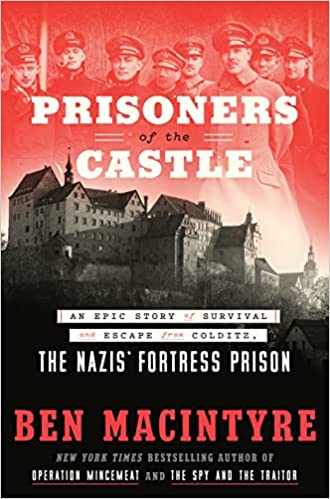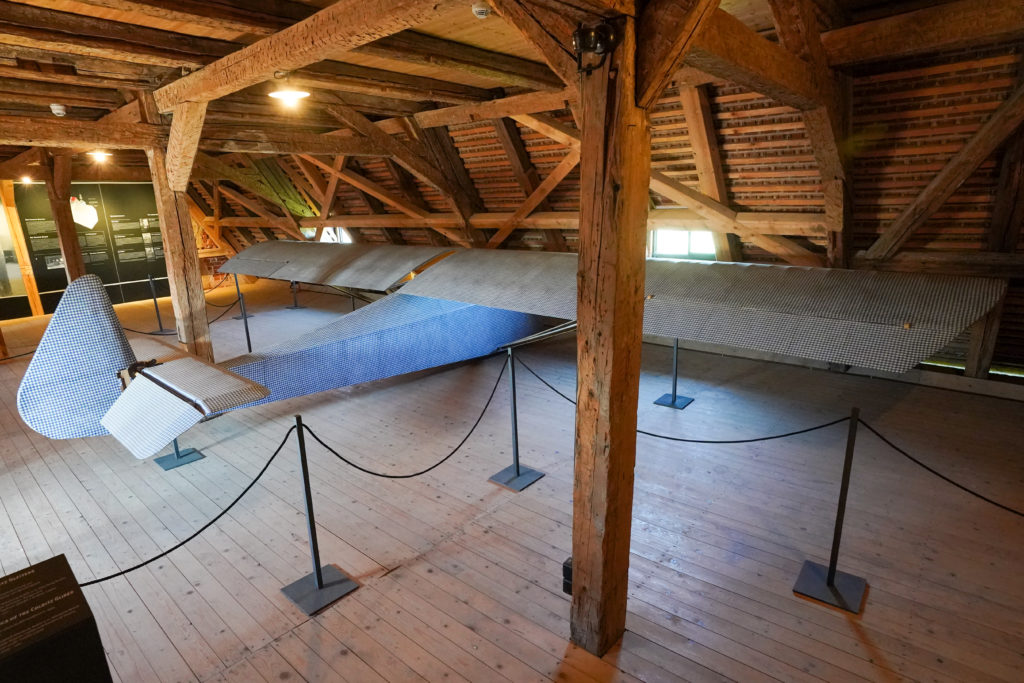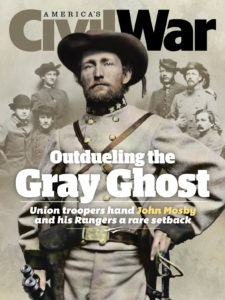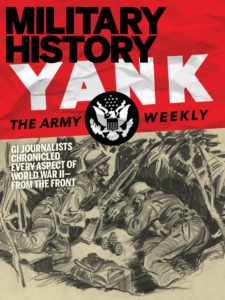From the silver to the small screen, Colditz Castle during the Second World War has captured audiences in the West for over 75 years. Stories of ingenuity (the Colditz Cock, anyone?), bravery and swashbuckling officers with perfectly maintained mustaches playing a cat and mouse game with Nazis all while being held in captivity is worth its weight in Hollywood gold.
Such stories have been firmly mined by historians and screenwriters alike. Or have they?
Author Ben Macintyre recently spoke with HistoryNet about the notorious prison camp, and how, after all these years and countless retellings, there’s still so much to unearth.
You have often written these incredibly unique stories about these larger-than-life characters — who have been, more often than not, lost to history. What in particular drew you to the POWs at Colditz?
Colditz is the most symbolic, famous, notorious wartime prison camp in history — it’s buried in our national mythology. It’s absolutely central to it. I grew up watching the black-and-white TV series about Colditz. I grew up playing the board game of Colditz.
And so along with that kind of heavy symbolism comes a lot of mythology. There is a very clear legend associated with Colditz. To sort of to simplify it, it’s the legend of brave Brits with mustaches, winning the war in a different way by defying the German captors and digging their way out to freedom. Now, of course, there was a lot of that — there was a tremendous amount of bravery and resilience and a lot of incredible escape attempts. But what I found fascinating about Colditz is that it’s a kind of, it’s a strange, artificial, enclosed world that takes place in the middle of war.
These are all prisoners who were captured, most of them right at the beginning of the war. And what you get is this sort of a strange, febrile, very odd atmosphere, where different people behave in different ways. You find that some of them are incredibly tough and resolute, and others behave in different ways. What always fascinates me is how ordinary different people respond to circumstances, particularly in wars that are not of their making.
I just wanted to revisit that story really, because, like lots of wartime stories, what has come down to us is often rather simplified. The history of the Second World War is often, I think, presented as almost a moral fable. There’s a good side and a bad side, there are winners and losers, and the people who win it are on the right side of righteousness. And of course, that’s true to a great extent, but within that there’s also a much more interesting and moving and poignant set of stories to be told.

Prisoners of the Castle: An Epic Story of Survival and Escape from Colditz, the Nazis’ Fortress Prison
by Ben Macintyre, Crown Publishing, September 13, 2022
If you buy something through our site, we might earn a commission.
What were the dynamics inside Colditz like among the prisoners? Was there really a difference among British and American POWs?
Part of the myth is that Colditz was a very homogenous place where everyone worked together to achieve the single aim of defying the Nazis and getting out. The truth is it was riven with division.
There were divisions by nationality, obviously between the Germans and the Allies, but within the Allies, you have the Poles, you have the French, Dutch, Belgians, you have Americans, you have the British, and they all had slightly different ways of coping with this world that they were in. And one of the ways was an intense rivalry between the nations.
There were divisions of class. The Brits in particular are obsessed — still are — with the whole idea of class. Class was sort of imported into Colditz wholesale. These were officers, most of them. But they had orderlies to look after them. And those servants were also prisoners, but they were privates. There were ordinary soldiers who were not allowed to escape, so you had a kind of an extraordinary social cleavage, if you like, running straight down the middle of Colditz.
Rather shockingly, I discovered that the French prisoners, the French officers, had demanded that the Jews in the camp be removed to a different part. They did not want to share barracks with French Jewish prisoners. At the time, of course, the Germans saw this as a huge propaganda opportunity and leapt at it.
Another one of the stories that I found actually amazing was about a British officer who was Indian. He was a medic, a trained surgeon, and he suffered the most terrible racism in Colditz, but not from the Germans. It was the other white prisoners who treated him as a second-class citizen. He was told that he wasn’t allowed to escape because his skin color would mean that he was going to get caught, which might have been true, but it was still a profoundly racist thing to say. Yet he escaped. And his escape is absolutely astonishing. He walked 700 miles across Nazi-occupied Europe into Switzerland. His story has never been told because, in truth, he was the “wrong” color.
I think there are many elements of the Colditz story that have been suppressed, really. We have a different approach to the world these days from the way it was written up immediately after the war. I hope that yields a different, and perhaps more sympathetic, way of looking at what happens when you lock up 500 people for five years.
Can you speak more about some of the lesser-known figures that are no less remarkable?
Somehow, both the society at the time and the history that was written afterwards did not consider them worthy of inclusion in the main story. There are women in the Colditz story. It was a prison camp for male officers and yet there are two women who played an absolutely crucial role in the history of Colditz. One was a middle-aged Scotswoman named Jane Walker who ran the escape networks out of Poland. Her cover was being a Polish housewife, but she was actually an MI6 officer. The prisoners who did manage to get out of Colditz went straight for her. She was vital.
The other one was a very young dental assistant, believe it or not, in the village in Colditz, who contrived, amazingly, to have a love affair with one of the characters inside the prison. It turned out that she herself was a committed anti-Nazi resistance operative inside of the town, and she ended up passing intelligence information to the prisoners inside, which was then sent back in coded letters. She has never appeared in this story. She does now.
Germany’s “escape-proof” POW camp, Colditz was, in fact, pretty escapable. There were some ingenious attempts made by British and American officers. Are there any that stand out to you? The Colditz Cock glider, for example?
Oh, it was real. It was built. I mean, this was an actual glider that was built in the attic of Colditz. It involved 600 different pieces of wood, fabric made out of bed mattresses and a steering mechanism. The idea was that they would, as an emergency measure, catapult off the roof. There was to be a runway built on the apex of the longest roof and then they would use a weight filled with concrete, which they could use as a counterweight to drop it off the end to literally fling this thing into the air over the Mulde River. Now, it never flew but it undoubtedly existed.

I think it was a way of keeping themselves from going a bit mad towards the end, but there were these other incredible escapes. That was partly because the Germans in their wisdom had decided to put all the most difficult prisoners, all the prisoners from other prison camps that had already tried to escape, they decided to put them in one place in the belief that if you put all the bad boys in one in one classroom, somehow, you’ll be able to keep control. As we all know, if you put all the naughty boys in one room, they’re egging each other on and very soon your classroom is on fire. So it actually turned out to be very counterproductive.
And while this vast Gothic castle on a hill is extraordinary and looks impregnable, it’s actually full of holes. Colditz was riddled with underground passages and secret compartments. One of the more intelligent German officers did say, “You know, it’s probably the worst place we could have chosen to try and keep 500 extremely difficult, escape-prone prisoners.” And so right from the word “go” there was a battle on between the escapees and the guards to see to see who would come out on top.
While it wasn’t implicit, both British and American officers felt that it was their duty to escape. However, were there any instances of men deciding to simply wait out the war as a POW?
More than you would think. While there were plenty of escapers at Colditz, there were plenty of people who understandably decided that, particularly as the war moved towards its bloody climax, that it wasn’t worth it. Trying to get out of this prison was a very quick way to end up with a bullet in your head in an unmarked grave.
If you were an officer and you escaped from Colditz, probably the worst that would happen to you would be to be brought back and put in solitary confinement for a few weeks. But as the war moved on and it became bloodier and more brutal, the SS began to take control over the prison camp system. Many, many people inside decided that the danger of escape was simply too much.
That said, there was always a hardened core who never gave up who believed that it was their absolute duty to keep going. They were really in a pretty small minority by the end of it.
The main enemy in Colditz was boredom. We imagine stories of war full of life and movement and color. That’s not true of a prison camp. So, in a way the battle they were fighting was often a mental battle to stay alert, to stay sane. Some lost that battle. It’s a part of Colditz life that is seldom discussed, but there was a high incidence of mental illness and breakdown, self-harm and suicide. It wasn’t a jolly game for everybody. For many people it was a terrible traumatic experience that they never recovered from.
Is there something about the POW experience that lends itself to these types of narratives?
I think there is. In places like Colditz it does ask a rather essential question in an odd way. It asks, or at least I hope this book asks, the question of “What would you do?” How would you, as a reader, have responded to it? Which one of these characters would you have been? It’s obviously a question none of us can truly answer, but it’s an imaginative thing that I think popular history — if it works — does very, very well is to try to place you in the position of those few. And I think that’s why these narratives have such a grip on us.
We’d like to imagine that all of us would have that indomitable spirit to keep going, but would we have? And some of the people that I love most in this story are the least well known. They’re the modest ones who sort of did keep going but never pretended it was fun, never pretended that this was a jolly game. They just sort of stuck at it with a certain grim British humor. The Americans were the same. There were some extraordinary American prisoners in Colditz towards the end who really provided such a moral boost that they became almost mascots of the place.
So, I think that some of these “lesser characters” are not lesser characters, really. They’re just characters that have been hidden perhaps behind a brightness of the celebrities also came out of Colditz.
historynet magazines
Our 9 best-selling history titles feature in-depth storytelling and iconic imagery to engage and inform on the people, the wars, and the events that shaped America and the world.









GET HISTORY’S GREATEST TALES—RIGHT IN YOUR INBOX
Subscribe to our Historynet Now! newsletter for the best of the past, delivered every Wednesday.





